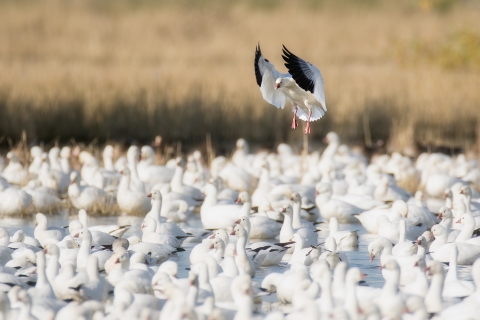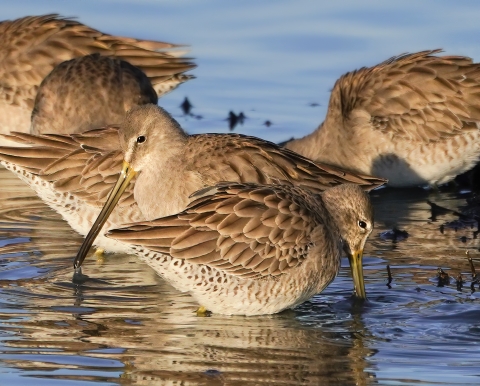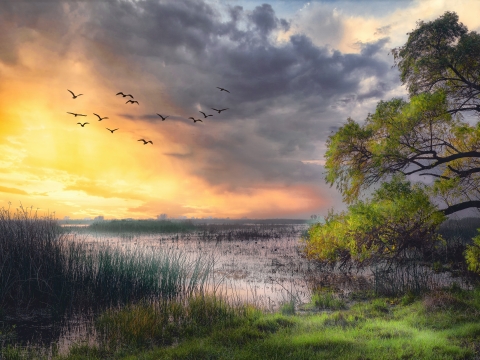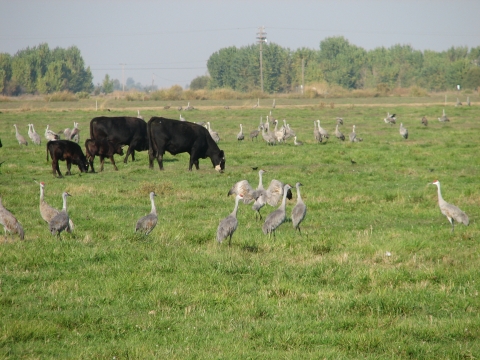What We Do
The National Wildlife Refuge System is a series of lands and waters owned and managed by the U.S. Fish and Wildlife Service. Wildlife conservation is at the heart of the refuge system. It drives everything we do from the purpose a refuge is established, to the recreational activities offered there, to the resource management tools we use. Selecting the right tools helps us ensure the survival of local plants and animals and helps fulfill the purpose of the refuge.
Refuge units are actively managed to provide critical habitat for wildlife. Past changes to the northern San Joaquin Valley – loss of habitats and species, alterations to natural hydrology, and the introduction of exotic plants and animals – necessitates proactive natural resources management activities by the refuge.
The refuge conducts an active wildlife and habitat inventory and monitoring program to collect information about plant and animal distributions and abundances, and to gauge the success of management programs.
For wildlife which has been locally extirpated, the refuge works with partners to reintroduce species to refuge units. Black-tailed deer have been reintroduced in recent decades to the refuge complex and surrounding landscape. The endangered riparian riparian
Definition of riparian habitat or riparian areas.
Learn more about riparian brush rabbit has been re-established on the San Joaquin River National Wildlife Refuge using rabbits reared at a captive breeding facility. The program has been successful with native-born rabbits now found throughout the refuge.
Artificial dens and other habitat structures have been constructed on the refuge to benefit wildlife with very specific needs. These include nest boxes for songbirds, owls, and wood ducks, dens for endangered kit foxes, and islands in wetlands for nesting and roosting waterfowl. Habitat management and restoration are primary activities at the refuge complex and require significant efforts to conduct.
Wetland habitat management requires an infrastructure of water conveyance canals, water control structures, pumps, and wells to manage the 150+ individual wetland units at the refuge complex. These wetland units support a tremendous variety and abundance of waterbirds. Most of the refuge’s wetlands are managed as moist soil units where important wetland food plants, in particular smartweed, watergrass, sedge, and swamp timothy are grown as forage for waterbirds. Seasonal wetlands are drained in spring, irrigated during the summer, and flooded in late summer through spring. The careful timing of flooding, draining, and irrigating wetlands encourages key wetland plants to grow and coincides with bird migration so that most wetland units are flooded and provide food when waterbirds are wintering in the Central Valley. In addition to seasonal wetlands, the refuge also maintains a smaller amount of year-round permanent wetlands and summer wetlands to provide habitat for breeding waterbirds.
Riparian woodlands are key wildlife travel corridors for many Central Valley wildlife species and provide unique breeding sites for many migratory birds. Thousands of acres of riparian woodland have been restored at the refuge complex to thriving communities that attract a diversity of wildlife, including endangered species such as the least bell’s vireo and riparian woodrat that were previously believed to be extirpated from the valley.
Management and Conservation
Refuges use a wide range of land management tools based on the best science available. Some refuges use prescribed fires to mimic natural fires that would have cleared old vegetation from the land helping native plants regenerate and local wildlife to thrive. Fire is a natural ecological process across most terrestrial habitats in North America. Many plants and animals have evolved to be fire adapted and depend on the effects of wildfire on the landscape. Fire management is a critical program at the Merced National Wildlife Refuge. The refuge’s fire program acts to extinguish all wildfires (to provide for public safety and protect natural resources) and to use prescribed or controlled fire for fuels management and for ecological purposes on its lands, including habitat improvement and maintenance, threatened and endangered species management, invasive plant reduction, nutrient recycling, improved forage for grazing wildlife and disease prevention.
Grazing animals play an important role in grassland and upland ecosystems. One normally thinks of natural grazers as hooved animals like tule elk, black-tailed deer, and pronghorn. However, grazers also include other herbivorous animals like rabbits, ground squirrels, kangaroo rats, and many insects. Vast herds of tule elk, black-tailed deer, and pronghorn once migrated through California’s Great Central Valley, feeding on the grasslands and shrublands, while also reinvigorating them. Those vast herds of large native grazers are gone now, and the number of small grazers has also greatly declined.
Today, domestic grazing animals like cattle, sheep, and goats are used on refuges to help play the role once filled by wildlife. Domestic cattle and sheep can frequently be seen on the San Luis and Merced refuges. Their presence is through cooperative agreements between private ranchers and the refuge complex. The program is mutually beneficial: ranchers gain a source of productive forage for their livestock, and countless wildlife species that evolved with open grassland habitats—long-billed curlews, horned lizards, and kangaroo rats to name a few—are better able to utilize these areas when the vegetation is shorter and sparser. Grazing programs on refuges also help control non-native “weedy” plants. Grazers remove the thick thatch that hinders the growth of many beneficial native plants, creating more open uplands like the bunchgrass-dominated grasslands historically found in California’s Central Valley.
Refuge Planning
National Wildlife Refuge planning sets the broad vision for refuge management and the goals, objectives, strategies, and actions required to achieve it. Planning ensures that each refuge meets its individual purposes, contributes to the Refuge System’s mission and priorities, is consistent with other applicable laws and policies, and enhances conservation benefits beyond refuge boundaries.
Comprehensive Conservation Plans
Comprehensive Conservation Plans (CCPs) are the primary planning documents for National Wildlife Refuges. As outlined in the National Wildlife Refuge System Administration Act, as amended, the U.S. Fish and Wildlife Service (Service) is required to develop CCPs that guide refuge management for the next 15 years. CCPs articulate the Service’s contributions to meeting refuge purposes and the National Wildlife Refuge System mission. CCPs serve as a bridge between broad, landscape-level plans developed by other agencies and stakeholders and the more detailed step-downs that stem from Refuge CCPs.
View or download the CCP for San Luis NWR, Merced NWR, and Grasslands WMA.
View or download the Appendices, including the Environmental Assessment and step-down plans.
Step-down Plans
CCP step-down plans guide refuge-level programs for: (1) conserving natural resources (e.g., fish, wildlife, plants, and the ecosystems they depend on for habitat); (2) stewarding other special values of the refuge (e.g., cultural or archeological resources, wilderness, wild and scenic rivers, etc.); and (3) engaging visitors and the community in conservation, including providing opportunities for wildlife-dependent recreation. Like CCPs, step-down plans contribute to the implementation of relevant landscape plans by developing SMART (Specific, Measurable, Achievable, Relevant, and Time-bound) objectives, strategies, implementation schedules, and decision support tools to fulfill refuge visions and goals. This ensures that refuges are managed in a landscape context and that conservation benefits extend beyond refuge boundaries.
Law Enforcement
U.S. Fish and Wildlife Service law enforcement officers have a variety of duties and responsibilities. Officers help visitors understand and obey wildlife protection laws. They also work to ensure that visitors have safe experiences on national wildlife refuges. Federal wildlife officers work closely with state and local government officers to enforce federal, state and refuge hunting regulations that protect migratory birds and other game species from illegal take and preserve legitimate hunting opportunities.
Laws and Regulations
All areas of the refuge are closed to public entry unless otherwise explicitly posted as an auto tour route, nature trail, hunt area, or parking lot.Some areas are closed seasonally and are posted as such.
Visitors to national wildlife refuges must comply with all applicable local, state, federal regulations and signs.
Walking is not allowed on refuge automobile tour routes.
Hours – San Luis NWR, Merced NWR, and San Joaquin River NWR are open daily from ½-hour before sunrise to ½-hour after sunset.






